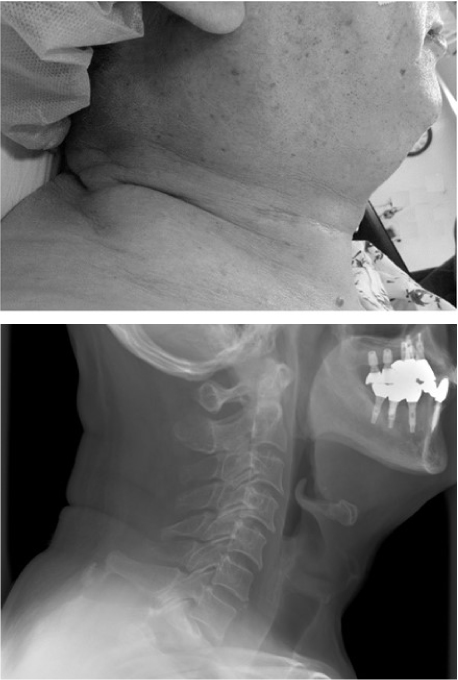J Dent Anesth Pain Med.
2015 Sep;15(3):181-184.
Blind nasal intubation as an alternative to difficult intubation approaches
- Affiliations
-
- 1Department of Anesthesiology and Pain Medicine, Asan Medical Center, University of Ulsan College of Medicine, Seoul, Korea. superoxide@naver.com
Abstract
- Airway difficulties are a major concern for anesthesiologists. Even though fiberoptic intubation is the generally accepted method for management of difficult airways, it is not without disadvantages-requires patient cooperation, and cannot be performed on soiled airway or upper airways with pre-existing narrowing pathology. Additionally, fiberoptic bronchoscopy is not available at every medical institution. In this case, we encountered difficult airway management in a 71-year-old man with a high Mallampati grade and a thick neck who had undergone urologic surgery. Several attempts, including a bronchoscope-guided intubation, were unsuccessful. Finally, blind nasal intubation was successful while the patient's neck was flexed and the tracheal cartilage was gently pressed down. We suggest that blind nasal intubation is a helpful alternative in difficult airway management and it can be a lifesaving technique in emergencies. Additionally, its simplicity makes it a less expensive option when advanced airway technology (fiberoptic bronchoscopy) is unavailable.
Keyword
MeSH Terms
Figure
Reference
-
1. Shiga T, Wajima Z, Inoue T, Sakamoto A. Predicting difficult intubation in apparently normal patients: a meta-analysis of bedside screening test performance. Anesthesiology. 2005; 103:429–437.2. Hagberg CA. Benumof and Hagberg's airway management. 3rd ed. Philadelphia: Elsevier Inc.;2013. p. 403–441.3. Apfelbaum JL, Hagberg CA, Caplan RA, Blitt CD, Connis RT, Nickinovich DG, et al. Practice guidelines for management of the difficult airway: an updated report by the American Society of Anesthesiologists Task Force on Management of the Difficult Airway. Anesthesiology. 2013; 118:251–270.4. Finucane BT, Tsui BC, Santora AH. Principles of airway management. 4th ed. St. Louis: Mosby;2011. p. 355.5. Kheterpal S, Healy D, Aziz MF, Shanks AM, Freundlich RE, Linton F, et al. Incidence, predictors, and outcome of difficult mask ventilation combined with difficult laryngoscopy: a report from the multicenter perioperative outcomes group. Anesthesiology. 2013; 119:1360–1369.
Article6. Gonzalez H, Minville V, Delanoue K, Mazerolles M, Concina D, Fourcade O. The importance of increased neck circumference to intubation difficulties in obese patients. Anesth Analg. 2008; 106:1132–1136.
Article7. Zhang J, Lamb A, Hung O, Hung C, Hung D. Blind nasal intubation: teaching a dying art. Can J Anaesth. 2014; 61:1055–1056.
Article8. O'Brien DJ, Danzl DF, Hooker EA, Daniel LM, Dolan MC. Prehospital blind nasotracheal intubation by paramedics. Ann Emerg Med. 1989; 18:612–617.9. Dronen SC, Merigian KS, Hedges JR, Hoekstra JW, Borron SW. A comparison of blind nasotracheal and succinylcholineassisted intubation in the poisoned patient. Ann Emerg Med. 1987; 16:650–652.
Article10. O'Connor RE, Megargel RE, Schnyder ME, Madden JF, Bitner M, Ross R. Paramedic success rate for blind nasotracheal intubation is improved with the use of an endotracheal tube with directional tip control. Ann Emerg Med. 2000; 36:328–332.11. Hagberg CA, Artime CA. Ariway management in the adult. In : Miller RD, editor. Miller's anesthesia. 8th ed. Philadelphia: Elsevier/Saunders;2015. p. 1670.12. Benumof JL, Cooper SD. Quantitative improvement in laryngoscopic view by optimal external laryngeal manipulation. J Clin Anesth. 1996; 8:136–140.
Article13. Hooker EA, Hagan S, Coleman R, Heine MF, Greenwood P. Directional-tip endotracheal tubes for blind nasotracheal intubation. Acad Emerg Med. 1996; 3:586–589.
Article14. Dyson A, Saunders PR, Giesecke AH. Awake blind nasal intubation: use of a simple whistle. Anaesthesia. 1990; 45:71–72.
Article15. Gorback MS. Inflation of the endotracheal tube cuff as an aid to blind nasal endotracheal intubation. Anesth Analg. 1987; 66:916–917.
Article
- Full Text Links
- Actions
-
Cited
- CITED
-
- Close
- Share
- Similar articles
-
- Orotracheal intubation in a patient with difficult airway by using fiberoptic nasotracheal intubation: A case report
- Effective removal of epistaxis during nasotracheal intubation utilizing a fiberoptic scope in a difficult airway: A case report
- Blind Intubation Using Fiberoptic Bronchoscope in Epistaxis
- Inferior turbinate outfracture for successful nasotracheal intubation in a patient undergoing maxillofacial surgery: case report
- Intubating Laryngeal Mask Airway in Difficult Intubation: A case report


